Improve your golf performance on the course with these at home exercises
5 simple exercises to do at home which will help improve your golf while also minimising injury risk.

With the British Open just around the corner, our team can help you improve your core strength, picking out the key exercises to improve your game. Golf has changed massively over the last decade or so, there is now a bigger focus on what golfers can do off the course to help them on the course. Alongside looking at what the professionals are doing studies are showing that strengthening exercises can improve golf performance (Kenny, Presnall et al. 2017).
The golf swing is a very complex movement; it is a series of timed movements with many different muscles firing at different times. Many studies have looked at the science behind the golf swing, if we look at it simply the basis of the modern day golf swing is a stable base (lower back + pelvis) with the trunk rotating around it (McHardy + Pollard, 2005). Based on this the main muscles we want to target in our home exercise program are our obliques and gluts which will help to stabilise our lower back. We also need to work on our shoulder muscles as they also need to be controlled throughout the golf swing. In relation to injury, we know that shoulder and lower back injuries are the most common injury sites in golf (Jeong, Na et al., 2018) so this is also a good reason to strengthen these areas to minimise injury risk.
Here are the 5 exercises:
Side plank + turn out
This fatiguing exercise works on controlling lower back rotation, so you want to keep you core engaged and lower back still throughout the whole exercise. It will be also working on shoulder blade control of the supporting side.
To regress you could hold the side plank for 10 seconds without opening the top hip.
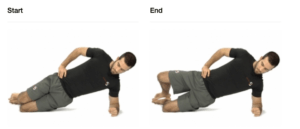
Bridge single leg extension
Again this is to control lower back rotation but there is more of a focus on the glut here. You want to make sure the hips stay level throughout the whole movement.
To regress you could just hold in a double leg bridge without the leg extension.
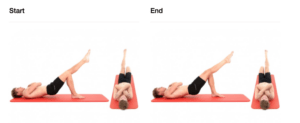
Opposite arm + leg
This exercise incorporates both shoulder and lower back control. You want to raise opposite arm and hand without any movement happening in the lower back or any change in the supporting shoulder blade.
To regress you can start with extending one limb at a time.
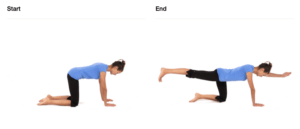
Lunge with thoracic rotation
This exercise will help to control lower back rotation, start with a slow rotation if performed well then you can progress to a faster speed but make sure you keep control.
Remember to switch legs to work both sides.
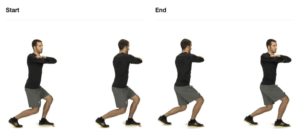
Dissociation upper back/lower back Timing
Our last exercise is most similar to our golf swing, you take your address position, cross your arms over your chest, first you move your upper back to the right, pause, then move your lower back to the right, pause, then go to the left with your lower back and then bring your upper body to the left. This mimics the timing of the golf swing while controlling and dissociating the two movements.
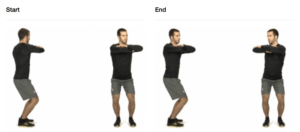
So try these 5 exercises at home, you can do them daily. Each exercise can be done 8-10 reps for 3 sets. Always make sure you’re controlling the movement, if you’re not then you can regress that exercises if needed.
References:
Lehman, G.J., 2006. Resistance training for performance and injury prevention in golf. The Journal of the Canadian Chiropractic Association, 50(1), p.27.
McHardy, A. and Pollard, H., 2005. Muscle activity during the golf swing. British journal of sports medicine, 39(11), pp.799-804.
Kenny, D.M., Presnall, J., Cosio-Lima, L. and Greska, E., 2017. The effects of a 5-week golf specific strength and conditioning intervention on swing performance factors. Br J Sports Med, 51(4), pp.339-339.
Joeng, H.S., Na, Y.M., Lee, S.Y. and Cho, Y.J., 2018. Injuries among Korean Female Professional Golfers: A Prospective Study. Journal of sports science & medicine, 17(3), p.492.